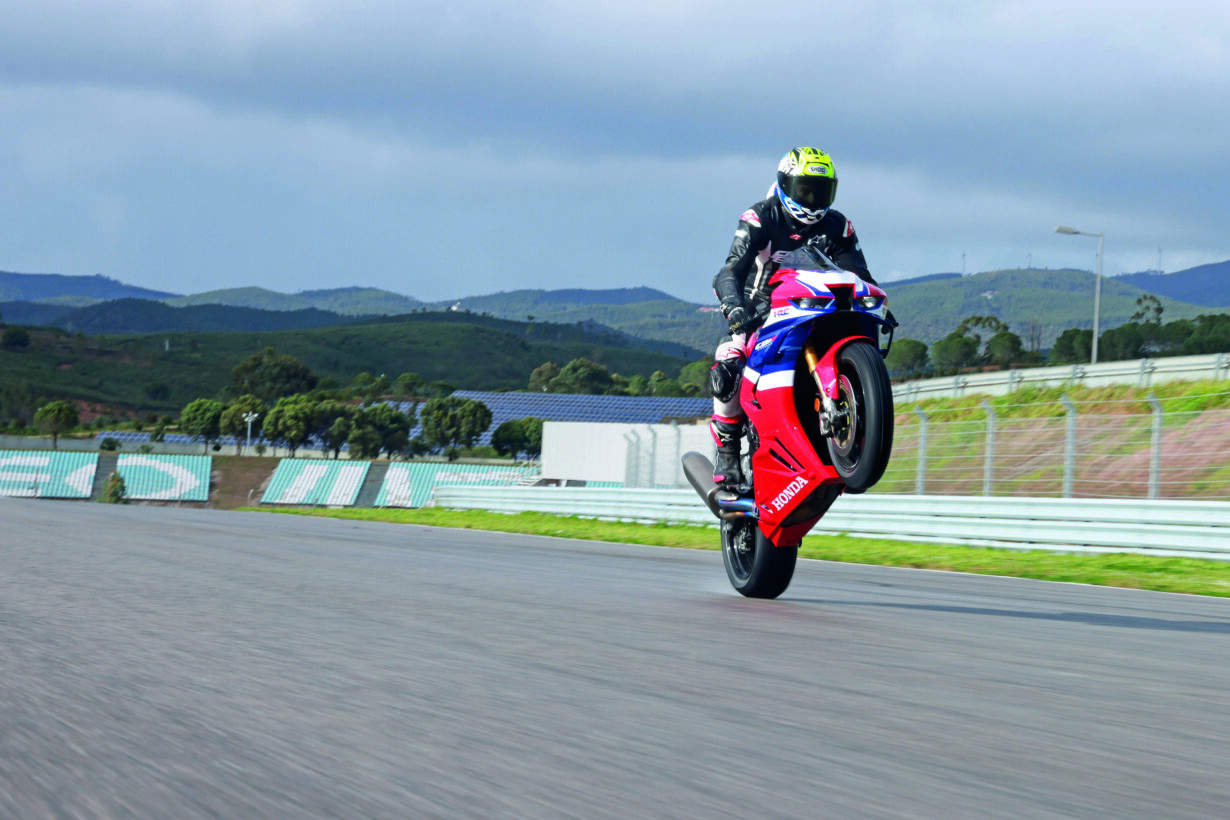Four years on from the revolutionary release of the RCV-inspired Fireblade, Honda’s given its flagship sportsbike a masterpiece of a makeover. Bruce Wilson reports…
While there is undoubtedly so much to love about the revolutionary Blades of the last few years, I’d be lying if I say that either of the 2020-plus machines have been a polished product, with odd niggles dampening the brilliance of this flagship headbanger.

The good news is that Honda has recognised this, going to town with the 2024 machine in more ways than you’d maybe imagine. Sure enough, the Blade sports a new tank, reworked bodywork, and has unmissably different wings that are smaller, mounted further forward, and still maintain the same amount of downforce while encouraging a more positive attitude for the front wheel.
Scratch the surface a little further and you’d be forgiven for thinking the frame is a mirror image of what’s come before, but that’s simply not the case; it’s been honed to within an inch of its life, losing a whole kilo in mass while being fine-tuned for big gains in torsional (-15%) and lateral (-17%) rigidity. Less weight is never a bad thing, and a chunk of the savings have come from removing internal bracing and expanding what is dubbed the thin-wall zone, but the real gain over the first iteration chassis is the added flex. The old frame was simply too stiff, unforgiving, and a hang-up for corner exits where grip was often compromised, made all the harsher by the Blade’s on/off power delivery.
To ensure all that hard work on the frame was capitalised on, Honda turned to Öhlins, once more to develop and deliver next-generation electronically-governed pogos. Called the S-EC 3.0, they feature new Spool Valve internals, refined settings and a fancy preload guide screen… more on that later. It’s all still governed through the proven five-inch TFT dash that features nine levels of traction control; five power modes; several user modes (including two that are customisable); three levels of engine braking; three levels of wheelie control; three settings for the quickshifter; and just for those occasions when you’re feeling a little fruity when leaving the supermarket car park, you even get traction control.
All of this was being hammered home during the model’s presentation in Portugal, frazzling my brain in the process – but not to the point of missing out on a particular soundbite that smacked a huge smile on my face. Let’s not beat around the bush: the ABS on the last two versions of Blade has been horrendous for track usage, but a new race addition of a calibration option means you can fully disengage the rear and all but do the same to the front, minimising any risk of intervention.
With my enthusiasm piquing, the moment finally came to get my head around the smorgasbord of changes made to the motor. While the output is still a saucy 214bhp, the way in which it reaches that impressive figure has changed significantly, with peak power and torque being achieved both 500rpm lower than before. That’s not a feat you often hear, with added revs typically being the gateway to more power up top. So, how have they managed it?
The motor’s makeover is so plentiful that it’s tricky to know where to start, but needless to say, while the bore and stroke has remained the same, pretty much everything else has had a good seeing to. But the real question was, just how would that translate? Armed with Pirelli SC3 slicks, we had two 20-minute sessions to our name, plus a raft of technicians from Honda and Öhlins to help us get the best from our bikes.
Portimao’s not shy of places to wind the tap open, and when doing so in full power mode, the Honda blew me away with its urgency. I genuinely wasn’t expecting the Honda to punch out of corners half as ferociously as it did. God only knows how they’ve got this thing through Euro emissions legislation, but I’m just pleased that they have, because in a world so soft it makes cotton wool seem harsh, this thing is nothing short of a tonic.
The front end on the bikes has always been the high point for me, and I was pleased to find that there’s no change there. The truth is, with only two sessions on track, getting stuck in with the fancy forks and shock was just never going to happen, but they made me feel comfy right away. With the bike set in A1, the most track-inclined automatic setting, I was getting good feel through the suspension and could tell what it was doing at all points.
There was so much to like about the new Fireblade, including the added gains of the Brembo Stylema R calipers that do an ace job of hauling the bike up. Even into the hardest braking point on track, at the end of the start straight, I never once got the ABS showing its ugly face, which was nothing short of reassuring and a revelation when compared to the sporadic ways of the old system. The lever feel was great, too, and the span remained consistent after each of the sessions on track, which is another bonus. After just two sessions, it was a massive tease to be walking away from this beast knowing that I had only just scratched the surface, but as the whetting of appetites go, this thing had made me ravenous for more. Trust me when I say that this bike is epic – because that’s the only way to describe it.




